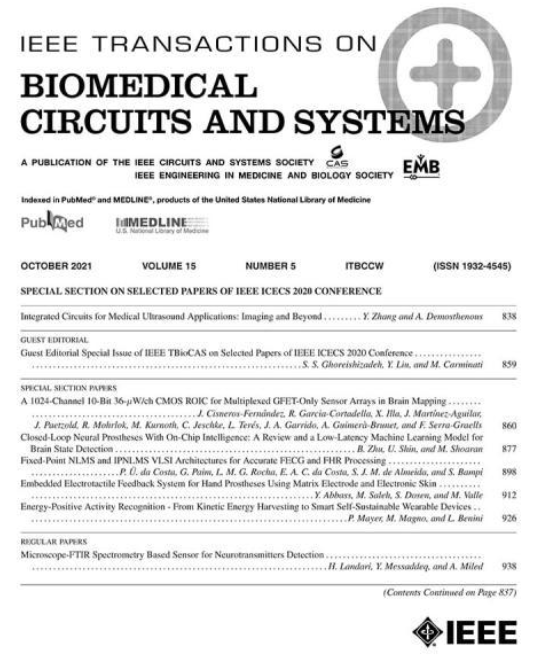在灵活的神经形态硬件系统中演示混合学习
IF 4.9
2区 医学
Q2 ENGINEERING, BIOMEDICAL
IEEE Transactions on Biomedical Circuits and Systems
Pub Date : 2016-04-18
DOI:10.1109/TBCAS.2016.2579164
引用次数: 109
摘要
我们介绍了神经形态硬件系统中学习和可塑性的新方法的结果:为了使可实现的学习机制具有灵活性,同时保持与神经形态实现相关的高效率,我们将通用处理器与全定制模拟元件相结合。该处理器与一个完全并行的神经形态系统并行运行,该系统由一系列连接到模拟连续时间神经元回路的突触组成。新型模拟相关传感器电路并行实时地处理每个突触的尖峰事件。处理器使用这种预处理来计算新的权重,可能会使用程序后面的附加信息。因此,在一定程度上,学习规则可以在软件中定义,具有很大的灵活性。突触在模拟域实现了以峰值时序相关可塑性(STDP)为中心计算原语的相关检测。与生物时间尺度相比,我们的工作速度加快了1000倍,测量的时间常数从几十微秒到几百微秒不等。我们分析了多个芯片之间的可变性,并使用乘法STDP规则演示了学习。我们的结论是,所提出的方法将使灵活和有效的学习作为神经科学研究和技术应用的平台。本文章由计算机程序翻译,如有差异,请以英文原文为准。
Demonstrating Hybrid Learning in a Flexible Neuromorphic Hardware System
We present results from a new approach to learning and plasticity in neuromorphic hardware systems: to enable flexibility in implementable learning mechanisms while keeping high efficiency associated with neuromorphic implementations, we combine a general-purpose processor with full-custom analog elements. This processor is operating in parallel with a fully parallel neuromorphic system consisting of an array of synapses connected to analog, continuous time neuron circuits. Novel analog correlation sensor circuits process spike events for each synapse in parallel and in real-time. The processor uses this pre-processing to compute new weights possibly using additional information following its program. Therefore, to a certain extent, learning rules can be defined in software giving a large degree of flexibility. Synapses realize correlation detection geared towards Spike-Timing Dependent Plasticity (STDP) as central computational primitive in the analog domain. Operating at a speed-up factor of 1000 compared to biological time-scale, we measure time-constants from tens to hundreds of micro-seconds. We analyze variability across multiple chips and demonstrate learning using a multiplicative STDP rule. We conclude that the presented approach will enable flexible and efficient learning as a platform for neuroscientific research and technological applications.
求助全文
通过发布文献求助,成功后即可免费获取论文全文。
去求助
来源期刊

IEEE Transactions on Biomedical Circuits and Systems
工程技术-工程:电子与电气
CiteScore
10.00
自引率
13.70%
发文量
174
审稿时长
3 months
期刊介绍:
The IEEE Transactions on Biomedical Circuits and Systems addresses areas at the crossroads of Circuits and Systems and Life Sciences. The main emphasis is on microelectronic issues in a wide range of applications found in life sciences, physical sciences and engineering. The primary goal of the journal is to bridge the unique scientific and technical activities of the Circuits and Systems Society to a wide variety of related areas such as: • Bioelectronics • Implantable and wearable electronics like cochlear and retinal prosthesis, motor control, etc. • Biotechnology sensor circuits, integrated systems, and networks • Micropower imaging technology • BioMEMS • Lab-on-chip Bio-nanotechnology • Organic Semiconductors • Biomedical Engineering • Genomics and Proteomics • Neuromorphic Engineering • Smart sensors • Low power micro- and nanoelectronics • Mixed-mode system-on-chip • Wireless technology • Gene circuits and molecular circuits • System biology • Brain science and engineering: such as neuro-informatics, neural prosthesis, cognitive engineering, brain computer interface • Healthcare: information technology for biomedical, epidemiology, and other related life science applications. General, theoretical, and application-oriented papers in the abovementioned technical areas with a Circuits and Systems perspective are encouraged to publish in TBioCAS. Of special interest are biomedical-oriented papers with a Circuits and Systems angle.
 求助内容:
求助内容: 应助结果提醒方式:
应助结果提醒方式:


